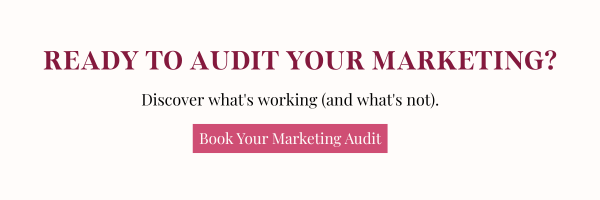Simplify Your Marketing Workflow with Smart Systems

Feeling overwhelmed by managing Instagram, email, blogs, and ads all at once? You’re not alone. Many wedding professionals struggle to stay consistent across channels. But with a streamlined workflow, you can simplify your marketing efforts while making a bigger impact.
In this blog, I’ll guide you through building a marketing workflow that keeps you organized, helps you stay on top of multiple channels, and lets you market your wedding business without the stress. From social media to email marketing, we’ll ensure every channel works together smoothly.
Difference Between a Marketing Plan, Strategy, and Workflow
Before we dive into the steps, let’s quickly break down the difference between a marketing plan, strategy, and workflow.
- Marketing Plan: This is the what—a document outlining your marketing goals and what channels you’ll use to achieve them. It’s the big-picture view.
- Marketing Strategy: This is the how—a detailed plan of how you’ll achieve your goals, focusing on messaging, audience, and tactics.
- Marketing Workflow: This is the execution—a day-to-day system or routine for managing and organizing marketing tasks across different channels.
In this blog, we’ll focus on creating a marketing workflow that helps you execute your strategy consistently across all your channels.
Step-by-Step Guide to Building a Marketing Workflow
Now that you understand the key differences, let’s dive into building a workflow you can easily follow month after month.
1. Set Clear Marketing Goals for Each Channel
Start by defining what you want to achieve on each channel. For example:
- Instagram: Grow by 500 followers per month.
- Email Marketing: Increase open rates by 10%.
- Blogging: Publish two new posts per month to drive website traffic.
Wedding professionals: If you’re a photographer, set goals like sharing one behind-the-scenes reel per week and featuring a testimonial post with a recent wedding client. For planners, aim to showcase unique venue setups or a design inspiration mood board weekly.
By setting clear goals, you’ll know what to track and adjust as you go along.
2. Organize Your Channels
List out every marketing channel you use—social media, email marketing, blogs, paid ads, etc. Next, set a frequency for each. How often will you post on Instagram? How many emails will you send each month? The goal is to create a routine you can follow consistently.
- Social Media: Daily Instagram posts, 3 TikToks a week.
- Email Marketing: Send 1 email per week.
- Blogging: Publish 2 blog posts per month.
Wedding Tip: Show your personality! Clients want to feel a connection, so use your social media to share personal stories or wedding-day tips. For example, share a “5 Things Brides Forget on Wedding Day” post with a checklist for your followers.

Social Media Workflow
Batch Content Creation
To save time, batch your content creation. Instead of creating one Instagram post per day, plan and create a week’s worth of content at once. The same goes for your other platforms like TikTok or Pinterest.
Here’s a mini-batch creation workflow to get started:
- Plan: Set aside 1-2 hours weekly to plan your content based on your goals.
- Create: Use a tool like Canva to design graphics, or Planoly to organize and schedule posts.
- Schedule: Use Planoly or Later to schedule Instagram content in advance, saving you time each day.
- Review: At the end of each week, review how your content performed and make adjustments as needed.
Wedding Tip: Include a #weddingtipwednesday post in your content plan. Share a tip about choosing vendors, picking the right timeline, or avoiding common planning mistakes to engage your audience and establish your expertise.
Tools for Social Media Management
- Planoly: Ideal for visual planning and scheduling Instagram posts.
- Later: Great for those who need a free scheduling option for multiple platforms.
- Enji: Allows you to schedule and manage several social media accounts from one dashboard.
Email Marketing Workflow
Emails are one of the best ways to nurture relationships with potential clients, but it’s important to be consistent.
Step-by-Step Email Workflow
- Plan Your Topics: Write down at least 4 email ideas for the month. These could be wedding planning tips, vendor spotlights, or behind-the-scenes stories.
- Write in Batches: Similar to social media, batch your email writing. Spend one day writing all the emails for the month.
- Segment Your Audience: Tailor your emails to different segments of your audience. For instance, send different content to leads, booked clients, and past clients. A wedding photographer, for example, can send sneak peeks of recent shoots to booked clients and “5 Reasons Why You Need an Engagement Session” to leads.
- Schedule in Advance: Use Flodesk or ConvertKit to schedule your emails, ensuring they go out on time even during busy wedding weeks.
Wedding Tip: Include a downloadable freebie like a “Wedding Day Emergency Kit Checklist” in your emails to encourage leads to sign up and engage with your brand.
Blogging Workflow
Consistent blogging builds your SEO and helps position you as a thought leader. But it’s often the first task that falls off your to-do list.
Streamlined Blog Workflow
- Topic Research: At the beginning of the month, write down a list of blog topics. You can use Google Trends or AnswerThePublic to discover what couples are searching for.
Example: If you’re a wedding planner, write a blog about “5 Venue Ideas for Small, Intimate Weddings” or “How to Plan a Multicultural Wedding.”
- Outline & Write: Spend one day outlining and drafting two blog posts for the month.
- Repurpose Content: Use blog excerpts or quotes to repurpose content for your Instagram or Pinterest posts. Cross-promoting will drive traffic back to your website.
- Schedule: Use WordPress or Showit to schedule posts ahead of time. This takes pressure off having to post manually.
Tracking KPIs
One of the key elements of a successful marketing workflow is tracking your progress. Monitor KPIs (key performance indicators) for each platform so you can adjust your strategy based on what works.
- Instagram: Track follower growth, engagement rates, and content reach.
- Email: Track open rates, click-through rates, and conversion rates.
- Blog: Track website traffic, time spent on page, and bounce rate.
Wedding Tip: For social media KPIs, take note of which posts lead to the most inquiries or direct messages. For example, you might discover that your “real wedding” posts with vendor tags and behind-the-scenes stories generate more DMs from potential clients.
Use a tool like Google Analytics or Enji to pull these insights and help you make data-driven decisions.

How to Combine All Your Marketing Workflows into One Cohesive System
Now that you’ve got workflows for social media, email marketing, and blogging, it’s time to pull everything together. By creating a unified system, you’ll ensure that each channel works in harmony, making your marketing more efficient and impactful.
1. Create a Master Calendar
Start by building a master marketing calendar where you can see all your content in one place. This should include:
- Social media posts
- Blog publishing dates
- Email campaigns
- Promotions or special offers
Tools like Trello, Clickup or Asana are great for managing a marketing calendar. This way, you’ll have a birds-eye view of what’s coming up and can ensure that your content across platforms aligns with each other.
2. Repurpose Content Across Channels
Repurposing is the key to working smarter, not harder. For example:
- Take an email newsletter topic and turn it into an Instagram carousel post.
- Use a blog post as the foundation for a series of social media stories.
- Extract quotes from your blog and share them on Twitter or Pinterest.
By reusing content, you save time and maintain consistency across all your platforms.
3. Schedule Everything in Batches
Once your content is planned and repurposed, it’s time to schedule. Use scheduling tools like Planoly or Later for social media, Flodesk for email, and WordPress for your blog. Schedule posts for the month ahead to keep things running smoothly, even during your busiest weeks.
4. Ensure Consistent Messaging
One of the biggest advantages of having a unified marketing workflow is consistency. Whether you’re posting on Instagram or sending an email, your messaging should reflect the same tone, style, and brand voice. This ensures that potential clients get the same experience, no matter where they interact with you.
5. Monitor and Adjust Regularly
Finally, review your performance regularly. Use analytics tools like Google Analytics and insights from your scheduling platforms to track how well your content is performing across channels. Based on the data, adjust your workflows as needed to ensure you’re getting the best results.
Common Workflow Challenges & How to Overcome Them
“I Don’t Have Time to Create Content”
If time is a concern, start small. You don’t need to be on every platform immediately. Focus on the ones where your audience is most active and build from there.
Wedding Tip: Use “Instagram Stories” for quick, behind-the-scenes updates from weddings. It doesn’t take much time, but it keeps your audience engaged and shows authenticity.
“I Don’t Know What Content to Post”
Engage with your audience! Ask them what wedding-related topics they want to learn more about. You can also pull inspiration from previous client FAQs, Pinterest trends, or blog posts that resonated.
Case Study: How One Wedding Planner Streamlined Her Marketing
One of our clients, a wedding planner managing 40 weddings annually, felt overwhelmed juggling Instagram, email, and blogging. We set up a marketing workflow that aligned with her busy schedule. By batching her social media posts and emails and repurposing blog content, she saw a 20% increase in email open rates and gained three new inquiries from Pinterest within three months. Streamlining her workflow helped her stay consistent and ultimately book more clients.
Simplify and Thrive
Building a marketing workflow may feel like a big task, but with clear goals, tools, and systems, it’s manageable—and effective. Remember to take it one step at a time. Start small, stay consistent, and adjust your workflow as you go.
Need help implementing this marketing workflow for your wedding business? Reach out today, and let’s build a system that works for you!
Sources:
The Importance of Consistent Posting for Social Media Creators, www.adobe.com/express/learn/blog/consistent-posting-creators. Accessed 23 Sept. 2024.
“Paid Advertising 101: A Beginner’s Guide.” Semrush Blog, www.semrush.com/blog/paid-advertising/?msockid=0e6a675f3f8266b90f8873653e4067aa. Accessed 23 Sept. 2024.

We make your systems and workflows easy breezy by working with you to create tailored, strategic solutions that save you time and make you money.
Ready to have someone streamline your systems?
Leave a Reply Cancel reply
© 2021-2025 BODA BLISS LLC. ALL RIGHTS RESERVED.
PRIVACY STATEMENT
Marketing Operations & Systems Setup for Wedding Professionals
Brand Photography by Lisa Kathan Photography
TERMS & CONDITIONS
Branding and Website Design by Emily Foster Creative